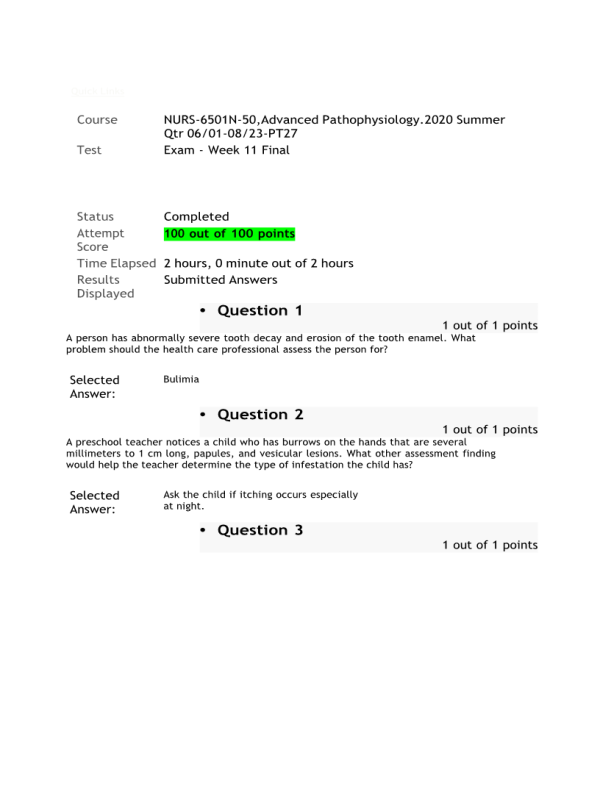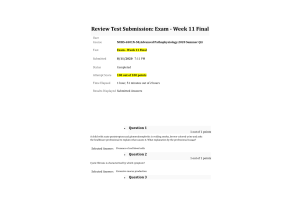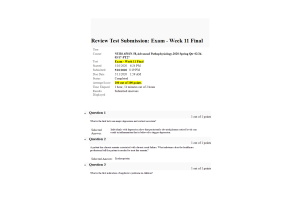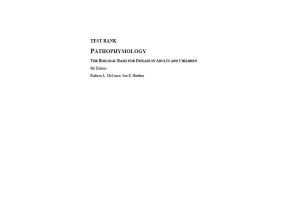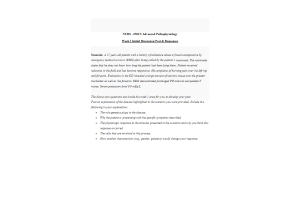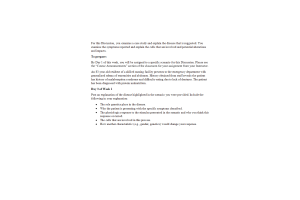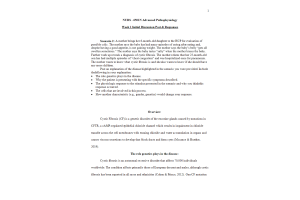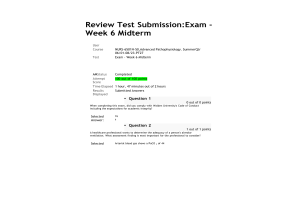NURS 6501N-50 Week 11 Final Exam (100 out of 100 points)
- $59.00
- Question: A person has abnormally severe tooth decay and erosion of the tooth enamel. What problem should the health care professional assess the person for?
- Question: A preschool teacher notices a child who has burrows on the hands that are several millimeters to 1 cm long, papules, and vesicular lesions. What other assessment finding would help the teacher determine the type of infestation the child has?
- Question: A healthcare professional is planning a community event to reduce risk of cerebrovascular accident (CVA) in high risk groups. Which group would the professional target as the priority?
- Question: Compared with an adult, an infant has a greater content of extracellular fluid, as well as a greater rate of fluid exchange. What effect does this have on the fluid balance of a child compared with that of an adult?
- Question: An infant has been diagnosed with intussusception and the student asks the healthcare professional to explain the condition. What explanation by the professional is most accurate?
- Question: In acute hypothermia, what physiologic change shunts blood away from the colder skin to the body core in an effort to decrease heat loss?
- Question: A patient is in the intensive care unit and has intercranial pressure (ICP) monitoring. The patient's ICP is 17 mmHg. The healthcare professional notes that the chart indicates the patient is now in stage 1 intracranial hypertension. What assessment finding does the professional associate with this condition?
- Question: A child has iron deficiency anemia. In addition to iron supplements, what else does the healthcare professional educate the parents on giving the child?
- Question: What is the link between major depression and cortisol secretion?
- Question: A parent brings a 10-year-old child to the clinic and reports a mottled appearance to the skin and legs cramps when the child is in physical education class. Physical assessment positive for upper extremity hypertension. What diagnostic testing or treatment does the healthcare professional prepare the family for?
- Question: An adult patient has been hospitalized with thrombocytopenia with a platelet count of 8000/mm 3. What action by the healthcare professional is most appropriate?
- Question: In which stage of syphilis would the following clinical manifestations be found: destructive skin, bone and soft tissue lesions, aneurysms, heart failure, and neurosyphilis?
- Question: A child has a disorder that resulted in the failure of bones to ossify, resulting in soft bones and skeletal deformity. What treatment plan does the healthcare professional discuss with the parents?
- Question: A healthcare professional works with recent refugees. A mother brings in her children who have been diagnosed with iron deficiency anemia. What action by the professional is most appropriate?
- Question: A healthcare professional advises a pregnant woman to add supplements of which nutrient to her diet to prevent birth defects?
- Question: What is the first indication of nephrotic syndrome in children?
- Question: A patient has polycythemia vera and presents to the Emergency Department with plethora and neurological changes. The student asks the healthcare professional to explain the primary cause of these symptoms. What response by the professional is best?
- Question: A patient in the hospital has been receiving heparin injections. The platelet count on admission was 222,000/mm 3 and four days later is 113,000/mm 3 . What action by the healthcare professional is best?
- Question: A person has been diagnosed with primary dysmenorrhea and wants to know why ibuprofen is a good choice for pain control. What response by the health care professional is best?
- Question: Which condition is consistent with the cardiac defect of transposition of the great vessels?
- Question: A criterion for a diagnosis of generalized anxiety disorder (GAD) is a period of excessive worrying that lasts for at least how many months?
- Question: A 7-year-old-child presents to the clinic where parents report signs and symptoms consistent with asthma. What does the healthcare professional do in order to confirm this diagnosis?
- Question: A baby is born with a myelomeningocele and needs urgent surgery to repair the defect. The parents want to take the baby home instead. What does the healthcare professional tell the parents about the purpose of this surgery?
- Question: A child has cystic fibrosis (CF). Which medication does the healthcare professional teach the parents about?
- Question: A newborn has meconium ileus. What diagnostic test does the healthcare professional advise the parents about?
- Question: Which cells function to maintain bone matrix?
- Question: A patient has ankylosing spondylitis. Which description of this condition by the health care professional is most accurate?
- Question: A child has Duchenne muscular dystrophy. What complication does the healthcare professional teach the parents is most important to control?
- Question: A health care professional is caring for a patient admitted to the hospital with severe anorexia. What action by the health care professional would be most important?
- Question: Which mother does the healthcare professional prepare to administer Rh immune globulin (Rho-GAM) to?
- Question: Which statement is likely true regarding children being treated for cancer with radiation therapy?
- Question: A healthcare professional suspects a patient is brain dead. How would the professional assess for brain death?
- Question: To quickly assess a patient's nervous system for dysfunction, what assessment should the healthcare professional perform as the priority
- Question: A 9-year-old child has a blood pressure of 112/72 mmHg in the school nurse's office. What action by the school nurse is most appropriate?
- Question: A patient has damage to the lower pons and medulla. What finding does the healthcare professional associate with this injury?
- Question: What are the clinical manifestations of testicular cancer?
- Question: A healthcare professional had taught a pregnant woman about the risk of transmitting herpes simplex virus (HSV) from her to her fetus. What statement by the woman indicates the professional needs to provide more information?
- Question: A patient has been hospitalized for a large deep vein thrombosis and states he is the third person in his family to have this condition in the last 2 years. What response by the healthcare professional is most appropriate?
- Question: A patient has defective secretion of the intrinsic factor leading to anemia. What treatment option does the healthcare professional discuss with the patient?
- Question: A health care professional is teaching a group of college women about increasing calcium in the diet to prevent osteoporosis. A participant asks at what age is peak bone mass is reached in women. What response is best?
- Question: The disruption in cellular adhesion observed in bullous impetigo is caused by an exfoliative toxin related to which organism?
- Question: In order to help prevent a preadolescent girl from developing later cervical cancer, which virus does the healthcare professional recommend vaccination against to the parent?
- Question: A healthcare professional in an urban clinic is seeing a patient who has iron deficiency anemia (IDA). What question by the professional is most appropriate to assess for the cause of IDA?
- Question: What is the role of thromboxane A (TXA 2) in the secretion stage of hemostasis?
- Question: A patient has a spinal cord injury at C4. What should the healthcare professional assess as the priority in this patient?
- Question: Clinical manifestations that include irregular or heavy bleeding, the passage of large clots, and the depletion of iron stores support which diagnosis?
- Question: Which bones are affected in Legg-Calvé-Perthes disease?
- Question: A student asks the healthcare professional why researchers are trying to link specific genes to specific asthma phenotypes. What response by the professional is best?
- Question: A patient is in the Emergency Department with heat stroke. What finding does the healthcare provider associate with this condition?
- Question: Hypothalamic-pituitary-adrenal (HPA) system abnormalities exist in a large percentage of individuals with what?
- Question: Bronchiolitis tends to occur during the first years of life and is most often caused by what type of infection?
- Question: A healthcare professional has educated a student on folic acid. Which statement by the student indicates that more teaching is needed?
- Question: A healthcare professional is seeing a patient with suspected schizophrenia. For which prenatal occurrence should the professional assess?
- Question: A patient had a seizure that consisted of impaired consciousness and the appearance of a dreamlike state. How does the healthcare professional chart this episode?
- Question: The student wants to know how the clinical manifestations and onset of juvenile idiopathic arthritis (JIA) differ from those of rheumatoid arthritis (RA) in adults. What answer by the healthcare professional is best?
- Question: A patient has been exposed to prolonged high environmental temperatures and now shows signs of dehydration, decreased plasma volumes, hypotension, decreased cardiac output, and tachycardia. What treatment does the healthcare professional prepare to administer to this patient?
- Question: In the majority of children experiencing delayed puberty, what is the problem caused by?
- Question: Parents bring their 1-year-old child to the emergency department, reporting that the child has been irritable and pounding on her head, has projectile vomiting, and seems very sleepy for most of the last 3 days. What diagnostic testing does the healthcare professional prepare the child and parents for as the priority?
- Question: Local signs and symptoms of Hodgkin disease-related lymphadenopathy are a result of what?
- Question: A person has been diagnosed with acute lymphocytic leukemia (ALL) that is positive for the Philadelphia chromosome. What statement by the healthcare professional is most appropriate?
- Question: Which statement by the healthcare professional accurately describes childhood asthma?
- Question: A woman has been diagnosed with polycystic ovary syndrome but is confused because her pelvic ultrasound (US) was read as normal and did not show cysts. What response by the health care professional is most appropriate?
- Question: Which immunoglobulin (Ig) is present in childhood asthma?
- Question: A healthcare professional is reviewing a patient's laboratory results and sees that the patient has a low reticulocyte count and a high iron level. Which type of anemia does the professional associate these findings with?
- Question: Which pain theory proposes that a balance of impulses conducted from the spinal cord to the higher centers in the central nervous system (CNS) modulates the transmission of pain?
- Question: A patient is 8 hours postoperative after a long orthopedic procedure. The student asks why this patient is at particular risk of developing a thromboembolism. What response by the healthcare professional is best?
- Question: A healthcare professional is caring for a patient diagnosed with aphasia. What action by the professional would be best in working with this patient?
- Question: A healthcare professional is trying to lower a patient's body temperature by convection. What action by the professional will accomplish this?
- Question: How is gonorrhea transmitted from a pregnant woman to her fetus?
- Question: A patient reports joint stiffness with movement and joint pain in weight bearing joints that is usually relieved by rest. What treatment option does the health care professional discuss with the patient?
- Question: Which condition is considered a clinical cause of amenorrhea?
- Question: A man reports to the healthcare professional that he had a sudden onset of malaise, low back pain, and perineal pain with high fever and chills, dysuria, nocturia, and urinary retention. What action by the healthcare professional is most appropriate?
- Question: A man has balanitis. What action by the healthcare professional is most appropriate?
- Question: A healthcare professional is caring for a patient who was rewarmed after suffering from hypothermia. What possible long-term complication will the professional continue to assess the patient for?
- Question: A professor explains to a class that the reason lymph nodes enlarge and become tender during infection is because of what reason?
- Question: An infant has a continuous machine-type murmur best heard at the left upper sternal border throughout systole and diastole. The healthcare professional suspects a congenital heart disorder. What other assessment finding is inconsistent with the professional's knowledge about this disorder?
- Question: An infant has gluten-sensitive enteropathy and the parents ask the healthcare professional to explain why the baby bruises so easily. The professional explains that the baby has which deficit?
- Question: A patient reports small, vesicular lesions that last between 10 and 20 days. What treatment does the healthcare professional educate the patient about?
- Question: A person comes to the healthcare clinic and reports night sweats and fever. The healthcare professional obtains a chest x-ray which shows a mediastinal mass. What other assessment or diagnostic test does the professional provide as a priority?
- Question: A patient is in status epilepticus. In addition to giving medication to stop the seizures, what would the healthcare professional place highest priority on?
- Question: A healthcare professional wants to volunteer for a community education project to help prevent spinal cord injury. What activity would the professional most likely volunteer for?
- Question: Cystic fibrosis is characterized by which symptom?
- Question: A patient has been diagnosed with lithium toxicity. Which electrolyte imbalance does the healthcare professional correlate with this condition?
- Question: A patient has been hospitalized with Guillain-Barré syndrome (GBS). The patient asks how this could have occurred. What response by the healthcare professional is best?
- Question: A patient has chronic anemia associated with chronic renal failure. What substance does the healthcare professional tell the patient is needed to treat this anemia?
- Question: What is the effect of low plasma albumin?
- Question: A student reads in a chart that a child has been diagnosed with mixed precocious puberty and asks for an explanation. What explanation by the healthcare professional is most accurate?
- Question: An infant is brought to the emergency department by parents who report that the baby's fontanels seem to be bulging outward. What action by the healthcare provider is most appropriate?
- Question: A healthcare professional is caring for a patient who has a spinal cord injury at T5. The patient exhibits severe hypertension, a heart rate of 32 beats/min, and sweating above the spinal cord lesion. How does the professional chart this event?
- Question: A pregnant woman is seen for the first time at 6 months' gestation and has not taken prenatal vitamins. The healthcare professional educates the woman on the need for a blood test specifically to assess what substance?
- Question: A woman attempting to conceive tells the healthcare professional that she and her partner have intercourse when her basal body temperature (BBT) is around 37˚C (98˚F) without getting pregnant. What information does the professional give the woman?
- Question: Parents report their 3-week-old infant who eats well and has gained weight began to have projectile vomiting for no apparent reason. What treatment option does the healthcare professional prepare to educate the parents on?
- Question: The health care professional is caring for a person who has a pathologic fracture. The patient asks the professional to explain the condition. What response by the professional is best?
- Question: In infectious mononucleosis (IM), what does the Monospot test detect?
- Question: A patient has hepatomegaly, bronze-colored skin, and cardiac dysrhythmias. What condition does the healthcare professional prepare to teach the patient about?
- Question: A patient has a temporary displacement of two bones in a joint causing the bone surfaces to partially lose contact with each other. What treatment does the health care professional prepare the patient for?
- Question: Prenatal exposure to diethylstilbestrol (DES) can result in which type of cancer?
- Question: What directly causes ovulation during the menstrual cycle?
- Question: A health care professional determines that the student needs more education when the student makes which statement about treating bone infection?
- Question: The healthcare professor states that a patient has reached pain tolerance. What further information from the professor is most accurate?
- Question: When completing this exam, did you comply with Walden University's Code of Conduct including the expectations for academic integrity?
